LG 29EA93 Ultrawide Display - Rev. 1.09
by Chris Heinonen on December 11, 2012 1:20 AM ESTLG 29EA93—Color Quality and Color Gamut
Out of the box, there is no sRGB mode for the LG 29EA93 to use, so I went with the Standard mode for the default testing. As always, I try to aim for a D65 white point, 2.2 gamma, and 200 nits of light output. All measurements are done using ColorEyes Display Pro, and using a NIST certified i1Pro spectrometer.
Just as expected, the 29EA93 is nothing to write home about straight out of the box. The dE average is just over 7, and the white error is very high as well. Without a pre-calibrated preset this is what I’d expect to see and so this isn’t really a surprise at all.
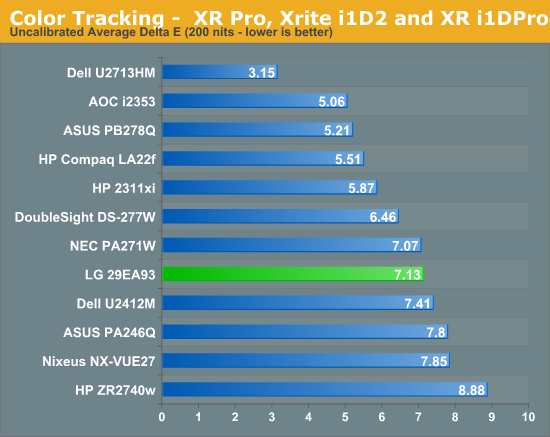
After a calibration, the LA 29EA93 fares much better. The average dE drops to a very respectable 1.61, and has a very low median dE of 1.33 as well. The main errors that are present are those that are hard for all displays to reproduce, such as certain blues, so this is a very nice calibrated result in the end for the LG.

When set to 100 nits that is more likely to be used for print media applications, the 29EA93 continues to have very nice calibrated results. The grayscale is nice and neutral, the colors are mostly accurate, and the resulting image is very nice on screen. Once calibrated the, LG 29EA93 produces an image that can keep up with the other IPS monitors out there.
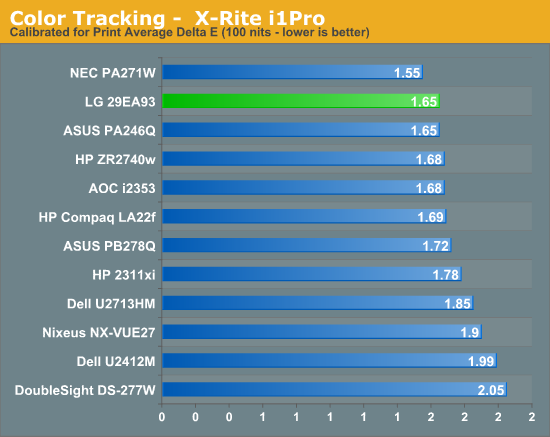
The one area that is does fall a bit short is in color gamut. It only covers 74% of the AdobeRGB gamut, which leaves it just a little short of the whole sRGB gamut. This little bit might not matter much in regular use, but it might matter more to those that are considering using it for color critical work.
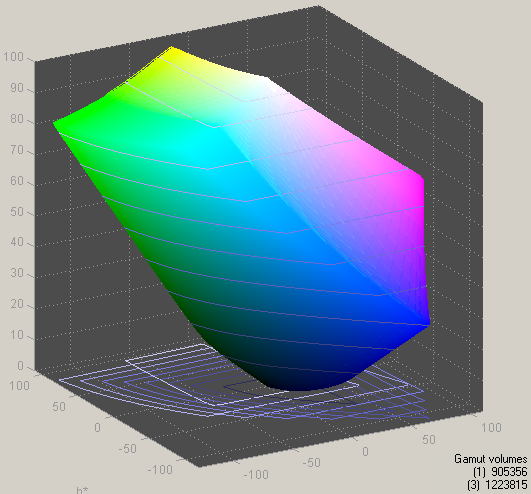
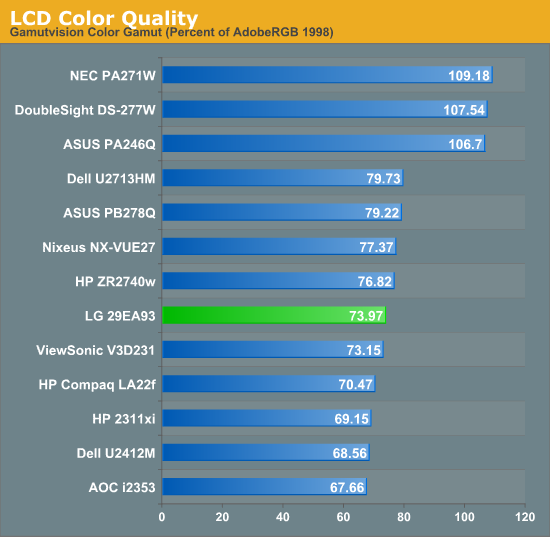


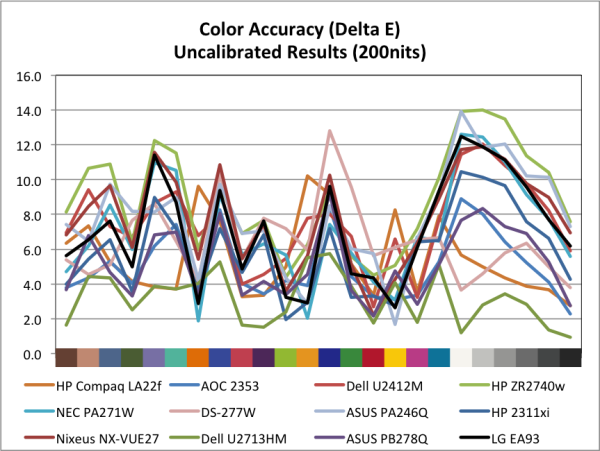
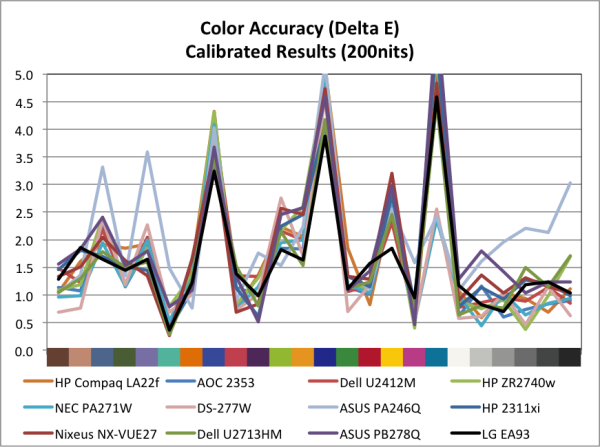
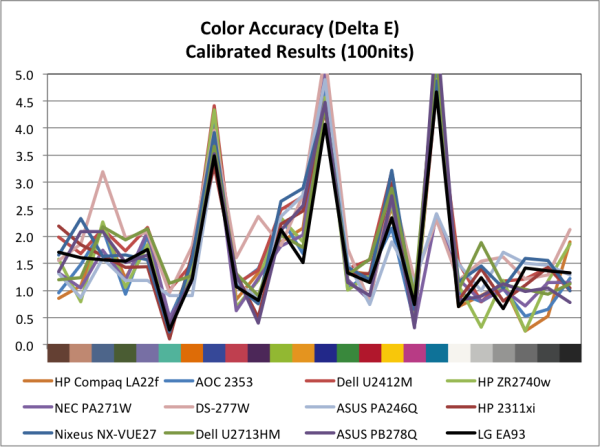








90 Comments
View All Comments
justniz - Wednesday, December 12, 2012 - link
The lack of 3D support seems like an obvious oversight, especially for a monitor that obviously targetted for movie and gaming use.I dont use 3D that much but I certainly wouldnt limit myself further by buying a monitor that couldnt support it at all.
cheinonen - Thursday, December 13, 2012 - link
Not having 3D is likely for a couple reasons:- Very few scalers actually work with a 3D picture. A Lumagen Radiance does, but that's $2000 to start with a basic model, and very few projectors with anamorphic mode support can do it to 3D. That would require a lot of extra power and push the price up.
- If they went passive 3D (which LG usually does), that's introducing a texture onto the screen that many people, like myself, can not tolerate on non-3D content.
Given that adding 3D would push the costs up a good amount probably, I think it's a pretty easy thing to drop.
Cannyone - Wednesday, December 12, 2012 - link
I recently found myself in need of a new display for my computer. And I was very interested in this new model. But I was afraid that some games wouldn't be able to utilize it. And I also worried that the input lag might be intrusive. So I ended up settling on the Asus PB278Q. Which I'm happy to say is working out quite well.I personally still wish I could get something like Vizio's Cinemawide TV for watching movies. But that will have to wait. However I commend LG for at least trying to fill this market niche. Its nice to see some companies that aren't afraid to take some risks.
SunLord - Wednesday, December 12, 2012 - link
Anandtech needs to review the Dell UltraSharp U2713HM same idea as this but it has display-port out so we can get some 6 display eyefinity going!peterfares - Wednesday, December 12, 2012 - link
In my opinion these are just stupid. A 27" 2560x1440 monitor is far better. Same horizontal room, more vertical room. 1080 vertical is pretty cramped once you get used to more.audioman83 - Thursday, December 13, 2012 - link
screen space-wise, how is this not better than 1920x1080????? more is more.Calista - Thursday, December 13, 2012 - link
I agree with Chris that a 27" is a better choice, but as compared to a 1920x1080-monitor it makes a lot of sense. 1920 by itself is just silly to work with in most cases, 1920 divided by two is only 960, far from enough for two work areas side by side. A browser need at least 1024 pixels, but even 1200 pixels is often a bit lacking. 2560 divided by two is much more workable.Jsuvexx - Thursday, December 13, 2012 - link
An monitor like this will be snatched up real fast by musicians, and folks in the multimedia industries.ReaM - Monday, January 21, 2013 - link
Anandtech crowd is a lot smarter than the rest of internet. I read a lot about 16:9 vs 16:10 back then when it came and people made ridiculous arguments for 16:9 stating that it's good for movies etc (while no movie has ever been shot in 16:9).If not for the loss of pixels I would vote for 16:9 but 1080 on these monitors is not much bigger than 1280x1024 what I had on my CRT 12 years ago. There is not really much more space on monitors, unless you get one of 1200 or 1440. I used to have the 27" iMac, it was nice, lots of space on the monitor.
dim.thelights - Thursday, April 4, 2013 - link
How to know which Rev. you will buy in the shop?Anyone know how to find out?